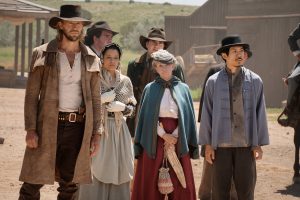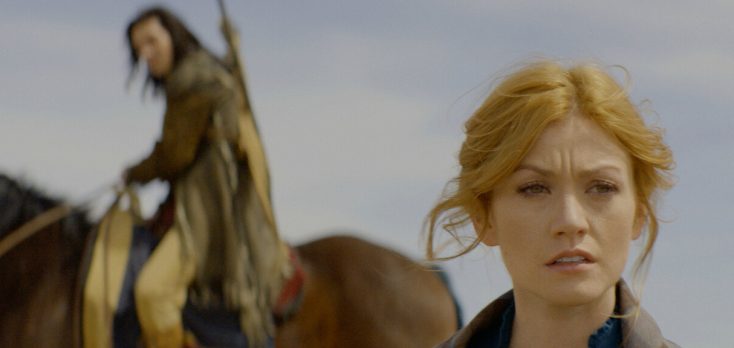
Matt Barr (far left) as Hoyt Rawlins and Lawrence Kao (far right) as Kai in WALKER INDEPENDENCE. ©The CW. CR: Richard Foreman, Jr. /The CW.
By JUDY SLOANE
Front Row Features
HOLLYWOOD-The producers of “Walker,” which stars Jared Padalecki as Texas Ranger Cordell Walker, have come up with a unique idea. An origin story set in the late 1800s entitled “Walker Independence,” which, according to the show’s Executive Producer and Showrunner, Seamus Fahey, was due to the fact that they had killed off a very popular character in the series, Hoyt Rawlins, Cordell’s best friend, played by Matt Barr (“Blood and Treasure,” “Hatfields and McCoys.”)
“Walker Independence” stars Katherine McNamara (“Shadowhunters,” Arrow”) as Abby Walker, a strong-minded woman from Boston who heads west with her husband Liam, who has secured a job as the sheriff of the new frontier boom town Independence, Texas. Liam is murdered on the range by a horse thief in front of Abby. Grief-stricken she wanders into Independence and begins to reinvent her life. She literally runs into Hoyt Rawlins (Barr), a rogue thief and gambler, turning the tables on him. It doesn’t take long for Abby and Hoyt to team up in an attempt to find her husband’s killer.
Katherine McNamara and Matt Barr spoke with the TV Critics Association via zoom to talk about their new western which debuts on The CW at 10 p.m. on October 6, 2022, following the season premiere of “Walker.”
Q: Matt, were you surprised to be approached about this project, especially when your character was killed off on “Walker?”
Matt Barr: I remember when Seamus [said,] “Hey, what if we went back in time?” And I’m like, “What, like two years before?” He’s like, “Maybe 150.” Love it.
Q: Katherine, how do you see Abby as setting the bar for the legacy of the Walkers who follow her?
Katherine McNamara: I’m always attracted to characters that are challenging and that have interesting stories to tell. And this was that. We read the pilot and Seamus had created such a wonderful world of characters that still felt as though it was akin to the world of Walker, but something new and fresh in a genre that held so much nostalgia and familiarity for so many people.
Q: Matt, obviously we saw a version Hoyt on “Walker.” Can you talk about how this Hoyt differs or compares to that Hoyt?
Barr: I always thought of the modern-day Hoyt as like a golden retriever with an unloaded gun. And the 1800’s Hoyt is like a German shepherd, he’s nice until you cross him. And then he’s gonna bite. 1800s Hoyt’s more dangerous. In the wild west, you had to survive. So I wanted to see that DNA in him. But I also liked the idea that you can’t really outrun your fate. There was that consistent recklessness in the Rawlins’ DNA that as we meet Hoyt 150 years later, [he’s] still trying to figure things out and gets in his own way. They’re equally charming.
McNamara: It’s true. That Rawlins’ charm is genetic, that’s for sure.
Barr: Yeah. I wanted to differentiate them, but also feel very much that same core bloodline there.
Q: Is there something that a viewer should look for that they would see that connects the two characters? A gesture or anything that’s something he would do?
Barr: I think there’s this little swagger, the way that Hoyt walks.
Q: How do both of you get into character for the show?
Barr: With our show, you walk onto our set, which is this western town in New Mexico. It’s beautiful and there are horses and goats and all these beautiful background actors. It’s like you’ve time-traveled. So it’s very easy to just walk right into that character, or maybe it’s a crutch. I don’t know.
McNamara: The world of the west is not always the happiest place to be, for lack of a better word. And to have this group of [actors] carry each other emotionally on those days where we have several emotional scenes stacked together, we feed off of each other’s energy, and the commitment to the character and the commitment to the story. It’s a beautiful, wonderful place to work.
Q: Katherine, can you talk about what Abby’s sense of justice is after her husband’s murder?
McNamara: With Abby, I think she’s a woman who’s a bit out of her time. She is very well educated, very intelligent, but still somehow finds [herself] in a world where she knows nothing. She has to completely start over her entire life, literally and stumbles into this town that is also finding itself.
It’s such an interesting opportunity to see a woman in this time period be able to start over on a life that is for her, to create her own destiny, while also trying to take revenge for the death of the love of her life. And try and find some sense of justice in a world where justice is always a shade of gray.
Q: We don’t often see westerns that are told from a female perspective.
McNamara: My favorite thing about my job is that I get to be a storyteller. I think there are a few story tropes that are told over and over again. But, what makes stories interesting is when you find a new perspective, and it allows for us to show what we hope is a more historically accurate version of the west than perhaps we’ve been able to see before on screen.
Barr: I think a lot of the magic in the show is the interactions between these characters and how [the] story in general is about change, and how people reinvent themselves. And so, it’s fun to see how we ping-pong off each other.
Westerns are just badass. There’s horses, horse chases, bank robberies, gunfights, and romance. I’m a lover, not a fighter.
Q: Can you relate “Walker Independence” to any of the classic westerns?
Barr: What was cool about when Wyatt Earp and his brothers went to Tombstone [was] they were gunslingers that became lawmen. And I think we have some of that DNA in our show. What’s funny is that these sheriffs and lawmen were actually outlaws at one point in time. We see that in a lot of those classical westerns, like, “Tombstone,” to mention one.
McNamara: I think our whole goal here is to make something new. There’s the warm nostalgia of seeing a horse walking down a western street and women in these grand dresses. But the goal here is to create a new perspective on this genre, to create something that you haven’t seen before, and to shed light on things that are very uncommon in this genre. Yes, we will have homages to things throughout, but hopefully we can accomplish that.





